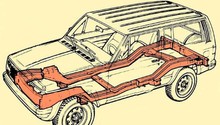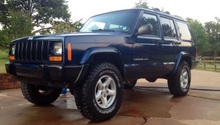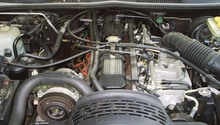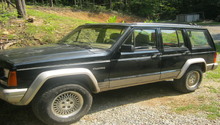Jeep Grand Cherokee 1993-2004: Suspension Noise Diagnostic Guide
You ever see, or I should say hear, that car that's driving down the road and it sounds like it's making a ton of noise? Well don't be that person. Here's how to diagnose that noise, so you can quiet your car up.
This article applies to the Jeep Grand Cherokee ZJ/WJ (1993-2004).
Suspension noises can be frustrating. They are often times elusive and difficult to figure out because they might not happen all the time. It might only make the noise when you're driving on a certain type of road and a certain type of speed. The thing to keep in mind, though, is that the noise has to be coming from somewhere, so with a bit of patience and a plan, you can pinpoint where that annoying noise is coming from.
For starters, every once in a while you should drive with your music off and your windows down. A lot of people drive around in their little car cacoon most of the time and can't hear anything that's going on around them. Then one day they hear this loud ridiculous noise and can't seem to figure out what happened. Little do they realize that the noise appeared months ago, but because they couldn't hear it, they just kept on driving until it got so bad they had no choice but to hear it. That's the reason why it's a good idea to drive around every once in a while and listen just to make sure your car isn't making any noises it's not supposed to.
The next thing you want to keep in mind is that there are a lot of other systems and components on your vehicle that are affected by the suspension and vice versa. So it's very well possible that your noise might not even be a suspension noise.
Always make sure you have the correct air pressure in your tires before diagnosing any issues. The incorrect air pressure, whether over-inflated or under-inflated, can cause all types of noises and other issues. Checking this and making sure it is correct could end up saving you lots of time and money.


Materials Needed
- Flashlight
- Jack and jack stands
- Pry bar
- Rubber mallet
Before beginning the diagnosis of any system on your vehicle, you must become familiar with the components of that system and what their function is. The easiest way to do this is by finding a diagram or picture of it either in a manual or online somewhere. Go over it and see if you can identify each component and what it does. If there are some you cannot recognize, try and find some way to figure it out. The more you know, the better and easier it will be to diagnose your noise and where it's coming from.
Here is a diagram of the front and rear suspension on these years Jeep Grand Cherokees. I'm going to leave the labels for the numbers off and you see if you can identify what each one is.

Figure 2. Front suspension. 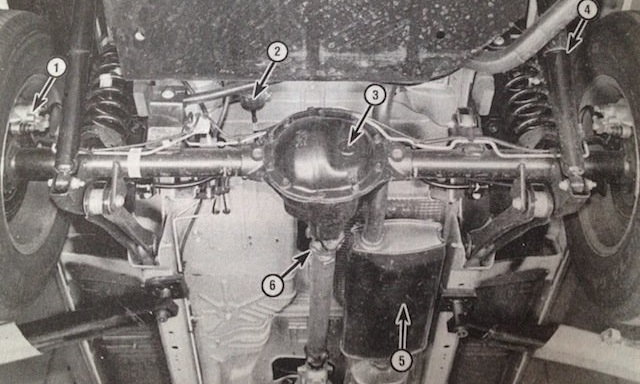
Figure 3. Rear suspension.
When diagnosing suspension noise, use a 3-step process to help narrow down what the issue could be. There have been times when this hasn't worked due to the noise being very tricky or actually from something else other than the suspension, but those times are usually rare and this process will work the majority of the time to help you figure out exactly where that noise is coming.
Step 1 – What type of noise is it?
The first step in diagnosing a suspension noise is figuring out what type of noise it is. This will help us determine the possible components that could be making this noise. Through experience, I have made a mental list of certain types noises that certain components can possibly make. I will list the types of noises that I'm familiar with and then what components could potentially make that noise.
- Squeak: Bushings, Ball Joints, Tie Rods, Steering Box, Coil Spring Isolators
- Squeel: Power Steering Pump, Wheel Bearing
- Creak: Bushings, Coil Springs, Coil Spring Isolators, Control Arms, Track Bar
- Clunk: Bushings, Shock, Shock Mounts, Track Bar Mount, Differential, Driveshaft U-Joints
- Rattle: Shock Mounts, Wheel Bearings
- Howl: Differential, Axles, Wheel Bearings
- Groan: Differential, Axles, Coil Springs
Along with the question of what type of noise it is, you will want to ask yourself is metallic or non-metallic? This will come in handy when determining the severity of it. Metallic noises are never a good sign and usually means something is past the point of holding off to fix it.
Step 2 – Frequency of the noise
The next step in our suspension noise diagnosis is asking our self what the frequency of the noise is. Now I'm not referring to its actual sound frequency, I'm referring to how or when it occurs. There are a few simple questions you can ask yourself to help figure this out.
- Is the noise rhythmic?
- Is the noise intermittent?
- Does the noise occur while in motion?
- Does the noise occur while standing still?
- Does the noise occur while under acceleration?
- Does the noise occur while under braking?
Identifying what kind of roads the noise appears on is also important. Does it occur on bumpy roads, over speed bumps, while the suspension is compressing, or while the suspension is rebounding? All of these are important to note when diagnosing noises.
Step 3 – What part of the vehicle is the noise coming from?
This is the last part of the 3-step process and will help to determine what exact component it could be. The components on the front of a vehicle compared to what components are on the rear are quite different. The front is responsible for turning, so it will make certain noises at certain times that the rear will never make.
When determining location, I usually break down the vehicle into quadrants:
- Front Left
- Front Right
- Rear Left
- Rear Right
This will help simplify where you will need to look. This will also help in determining where you will start to look when you actually get under there and start doing a visual inspection. Breaking it up into sections will keep you from getting confused and will also help in making sure you give a thorough inspection.
Answering the question of location, and knowing what type of noise it is will then lead us to start looking at components and determining if that is where the problem is coming from. Sometimes, it helps just to go under the vehicle and start staring at things. Usually it's pretty easy to tell when something doesn't look right.
Some things to look for:
- Freshly Shiny Metal
- Powdered Rust
- Torn Rubber Boots
- Grease Splatter
- Fresh Grease Leak
- Wetness
- Cracks
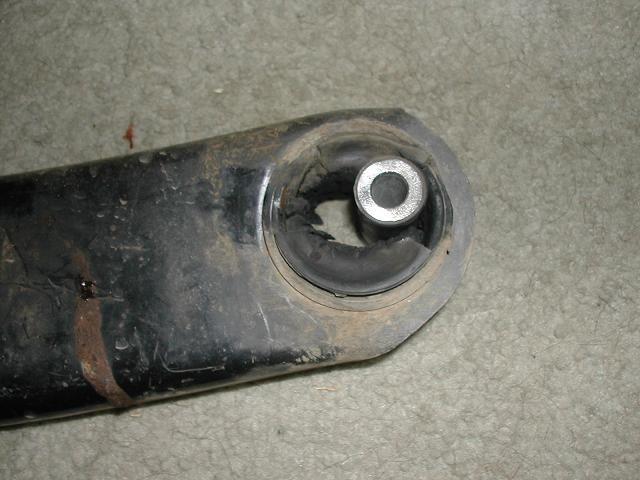
Figure 4. Worn control arm bushing. 
Figure 5. Broken shock mount. 
Figure 6. Control arm mount separating from frame due to corrosion. 
Figure 7. Torn ball joint boot.
Remember, when diagnosing any issue, it helps to stay patient and do your research. It can get frustrating at times, but I can tell you that if it's making a noise, there is a reason it is making the noise and you can figure it out in order to take care of it as long as you're willing to do so.
Featured Video: How to Find Suspension Noises
Related Discussions
- Grinding Noise When Turning Wheels - CherokeeForum.com
- Making Noise When Turning Left - CherokeeForum.com
- Popping Noise Up Front - CherokeeForum.com
- Can Bad Rear Bearings Cause Clunking Noise - CherokeeForum.com
- Banging Noise Driver's Side Rear - CherokeeForum.com


